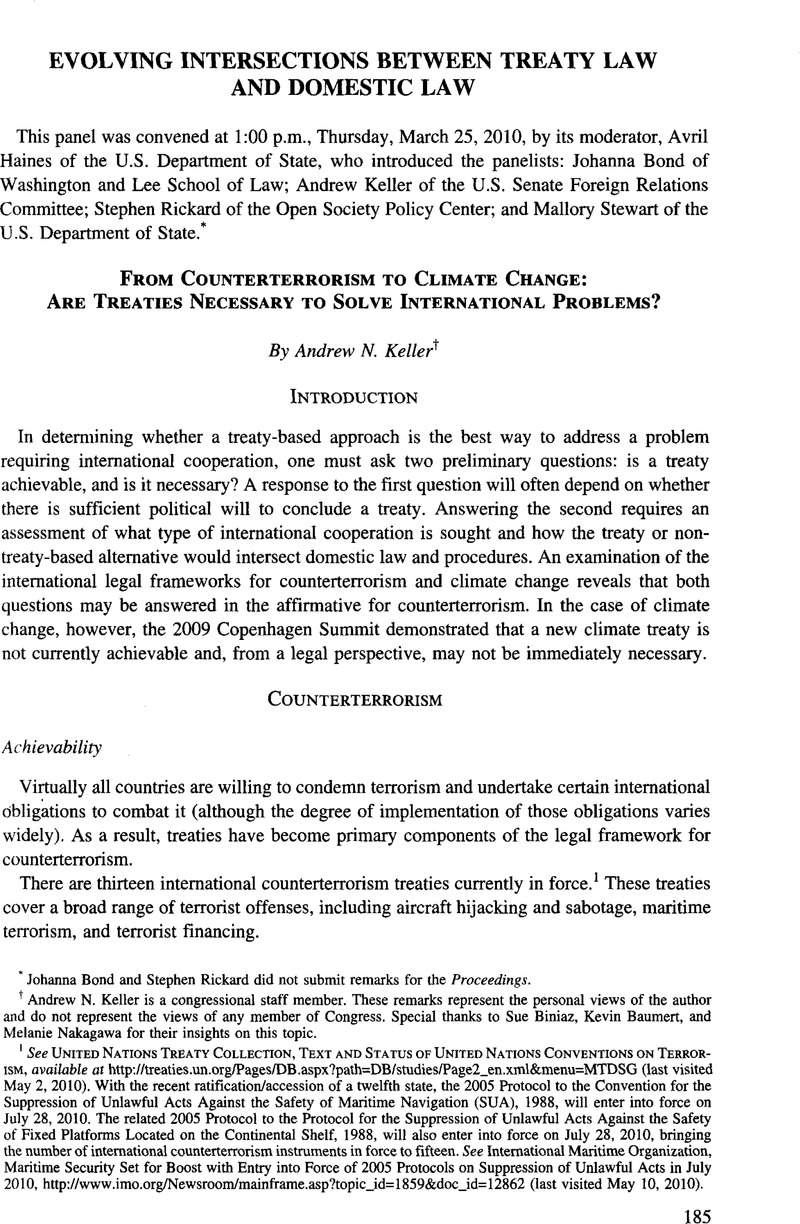No CrossRef data available.
Published online by Cambridge University Press: 28 February 2017

1 See United Nations Treaty Collection, Text and Status of United Nations Conventions on Terrorism, available at http://treaties.un.org/Pages/DB.aspx?path=DB/studies/Page2_en.xml&menu=MTDSG (last visited May 2, 2010). With the recent ratification/accession of a twelfth state, the 2005 Protocol to the Convention for the Suppression of Unlawful Acts against the Safety of Maritime Navigation (SUA), 1988, will enter into force on July 28, 2010. The related 2005 Protocol to the Protocol for the Suppression of Unlawful Acts against the Safety of Fixed Platforms Located on the Continental Shelf, 1988, will also enter into force on July 28, 2010, bringing the number of international counterterrorism instruments in force to fifteen. See International Maritime Organization, Maritime Security Set for Boost with Entry into Force of 2005 Protocols on Suppression of Unlawful Acts in July 2010, http://www.imo.org/Newsroom/mainframe.asp?topic_id=1859&doc_id=12862 (last visited May 10, 2010).
2 Convention for the Suppression of Unlawful Acts against the Safety of Civil Aviation, opened for signature Sept. 23, 1971, 24 Ust 564, 974 UNTS 177.
3 Id. at Arts. 3, 5(1) & (2), 7, & 8(1).
4 The requirement for dual criminality also generally includes a minimum penalty. For example, Article 2(1) of the Extradition Treaty between the Government of the United States of America and the Government of the Republic of Bulgaria provides: “[a]n offense shall be an extraditable offense if it is punishable under the laws in both States by deprivation of liberty for a maximum period of more than one year or by a more severe penalty.” Extradition Treaty Between the Government of the United States of America and the Government of the Republic of Bulgaria, Sept. 19, 2007, S. Treaty Doc. No. 110-12 (2007).
5 See e.g., Treaty of Extradition Between the United States of America and the Kingdom of Albania, Mar. 1, 1933, 49 Stat. 3313, TS 902, 5 Bevans 22.
6 United Nations Framework Convention on Climate Change, May 9, 1992, S. Treaty Doc. No. 102-38 (1992), 31 ILM 849 (1992) [hereinafter Unfccc].
7 For a list of parties to the Unfccc, see Unfccc, Status of Ratification of the Convention, http://unfccc.int/essential_background/convention/status_of_ratification/items/2631.php.
8 UNFCCC, supra note 6, at Art. 2.
9 Kyoto Protocol to the United Nations Framework Convention on Climate Change, Conference of the Parties, 3d Sess., Dec. 11, 1997, 37 ILM 22 (1998) [hereinafter Kyoto Protocol].
10 Id. at Art. 3 & Annex I.
11 Joseph E. Aldy & Robert N. Stavins, Post-KYOTO International Climate Policy: Summary for Policymakers 4-5 (2009).
12 Copenhagen Accord, UN Doc. Fccc/CP/2009/L.7 (Dec. 18, 2009), available at http://unfccc.int/documentation/documents/advanced_search/items/3594.php?rec=j&priref=600005735#beg [hereinafter Accord].
13 Id. at paras. 4-5.
14 Id.
15 For Copenhagen Accord submissions, see Unfccc, Copenhagen Accord, http://unfccc.int/home/items/5262.php (last visited May 10, 2010). Not surprisingly, given this bottom-up approach, many countries simply transformed their pre-Copenhagen mitigation pledges into submissions for purposes of the Copenhagen Accord. For example, compare the United States’ pre-Copenhagen mitigation pledge to its Copenhagen Accord submission, available at White House, Press Release, President to Attend Copenhagen Climate Talks, http://www.whitehouse.gov/the-press-office/president-attend-copenhagen-climate-talks (last visited May 10, 2010) and Unfccc, Appendix I— Quantified Economy-Wide Emissions Targets for 2020, http://unfccc.int/home/items/5264.php (last visited May 10, 2010).
16 Kyoto Protocol, supra note 9, at Art. 21(4). This provision requires that the Parties “make every effort to reach agreement on any proposed annex or amendment to an annex by consensus.” It further provides that if all efforts at achieving a consensus-based agreement fail, an amendment to an annex may be adopted as a last resort by a three-fourths majority vote of the parties present and voting. Id.